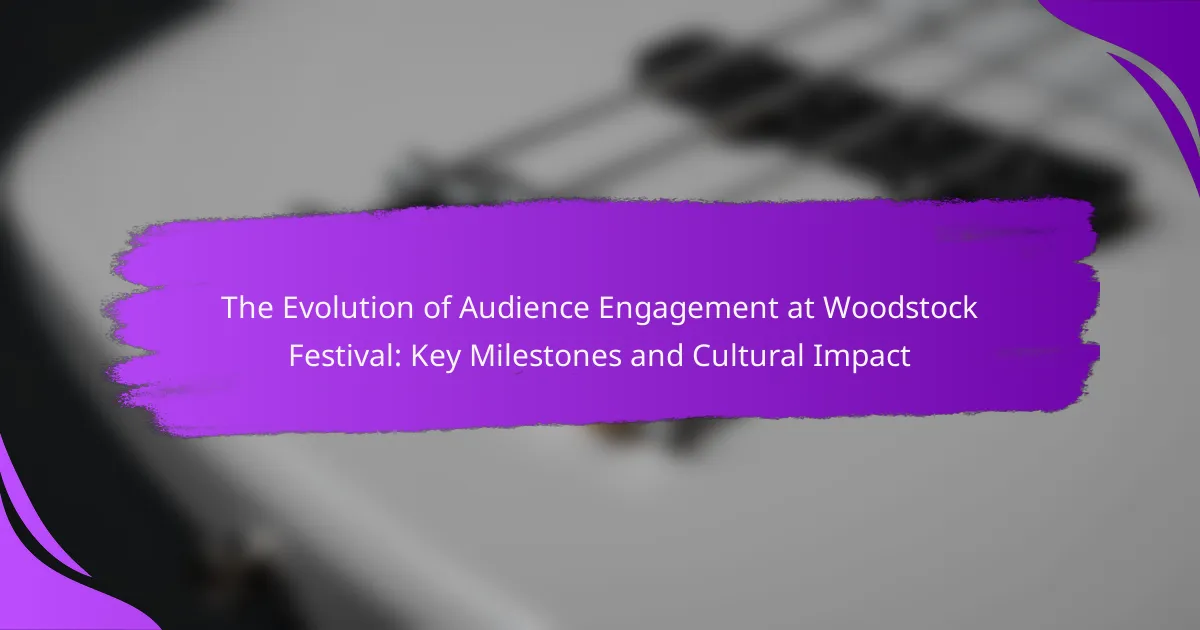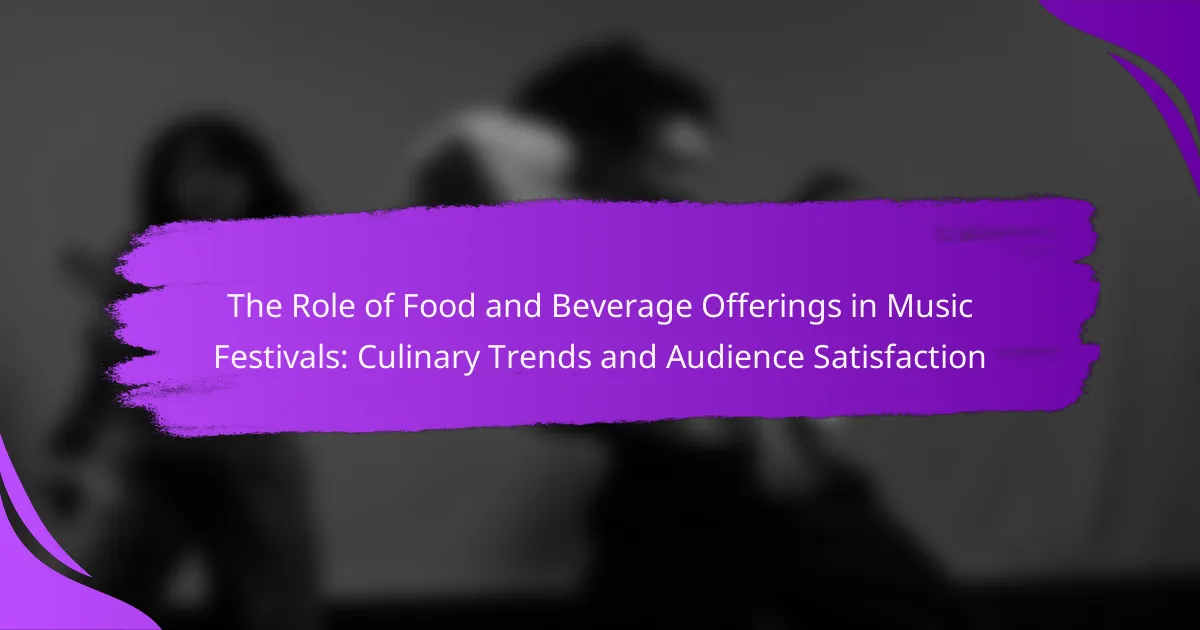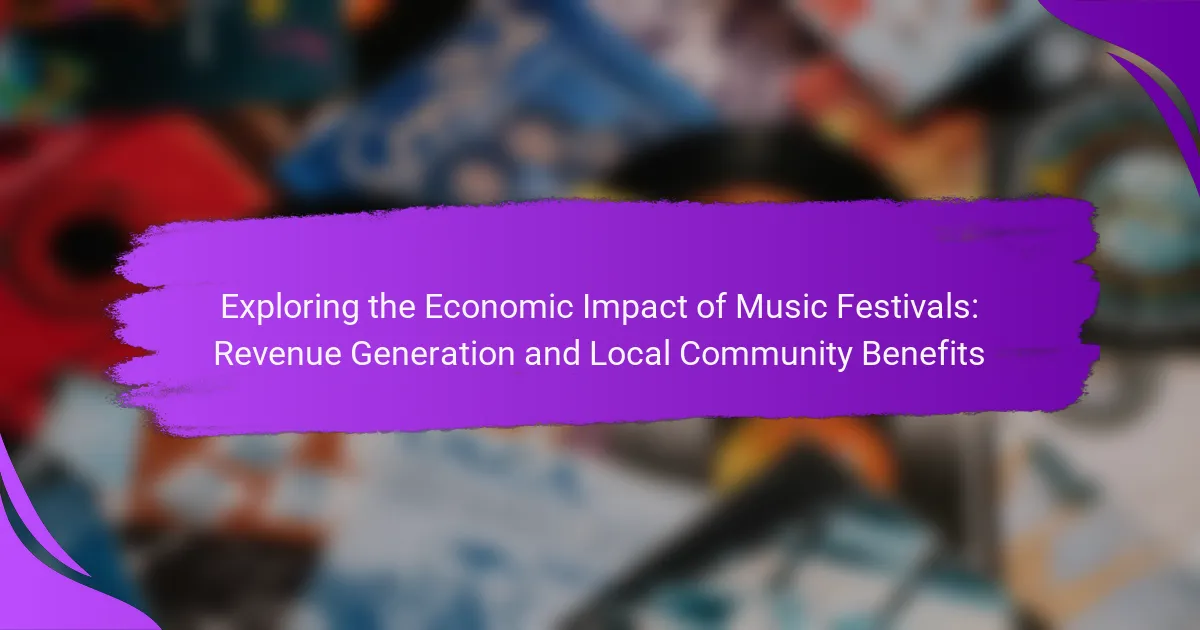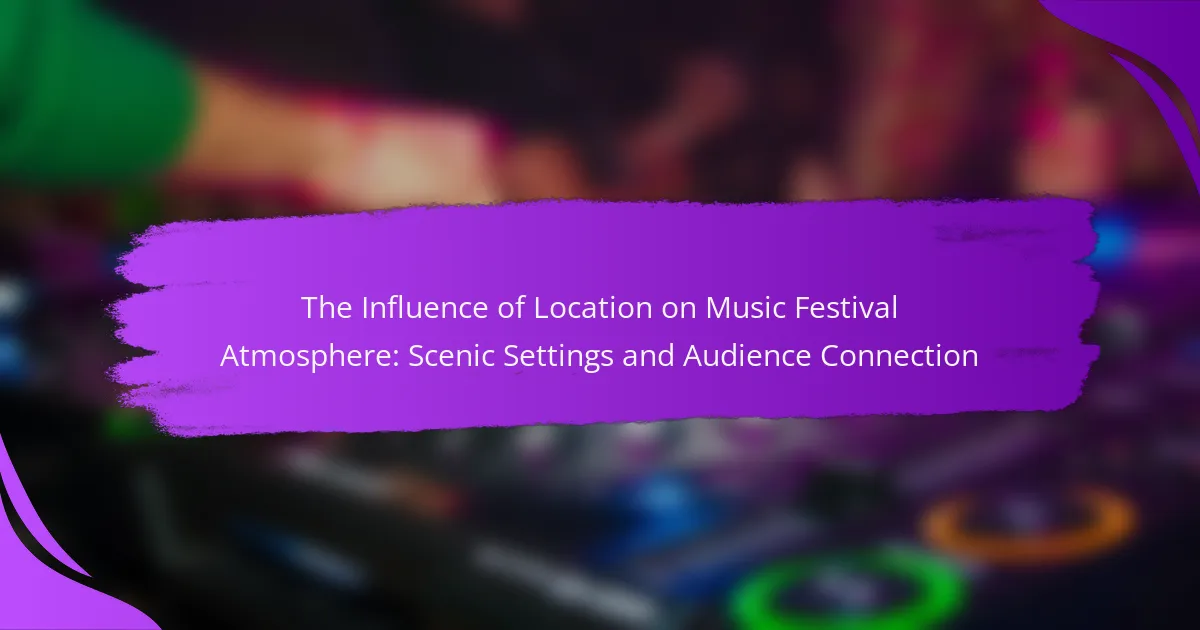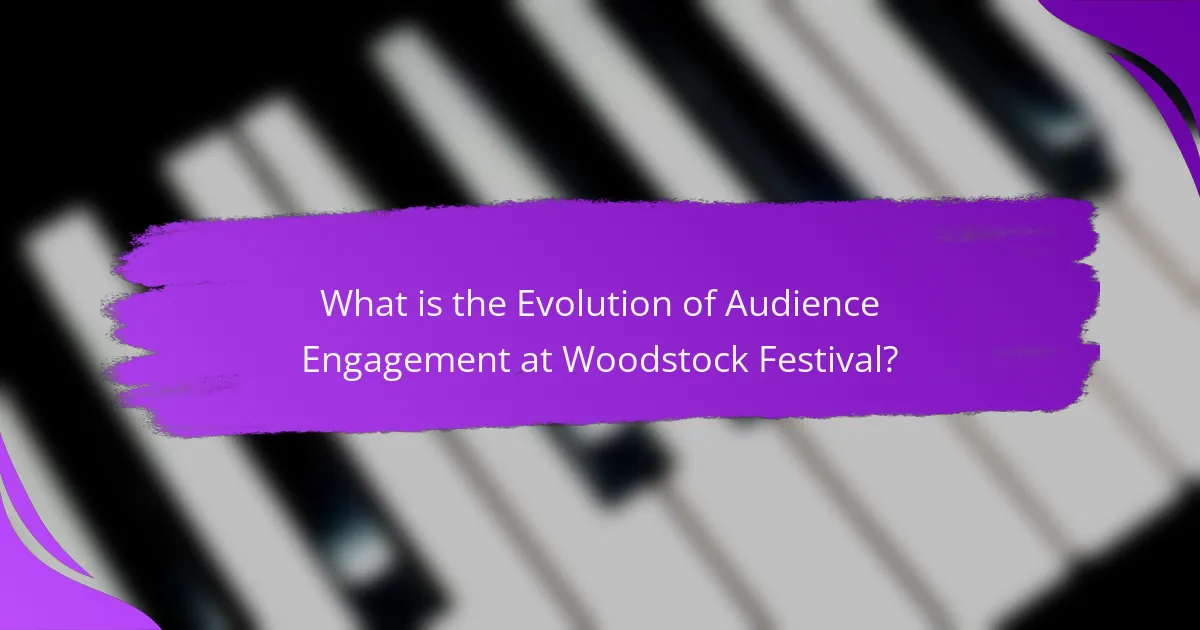
What is the Evolution of Audience Engagement at Woodstock Festival?
The evolution of audience engagement at Woodstock Festival reflects changing cultural dynamics. Initially, the 1969 festival focused on communal experiences and counterculture ideals. Attendees engaged through live performances, fostering a sense of unity. The festival’s iconic status was solidified by its emphasis on peace and music.
In 1994, the second Woodstock revived the spirit of the original. It featured a diverse lineup and interactive activities for attendees. The 1999 festival marked a shift towards commercialization. Increased security and higher ticket prices altered the engagement landscape. This led to tensions and a chaotic atmosphere.
In recent years, digital platforms have transformed audience interaction. Social media allows real-time sharing of experiences. Virtual attendance options have expanded engagement beyond physical limitations. Overall, Woodstock’s audience engagement has evolved from communal gatherings to a blend of physical and digital experiences.
How has audience engagement changed over the years at Woodstock Festival?
Audience engagement at Woodstock Festival has evolved significantly since its inception in 1969. In the early years, engagement was characterized by a strong sense of community and collective experience. Attendees participated actively, creating a shared culture through music and social interaction.
As the festival continued into the 1990s and early 2000s, audience engagement shifted. The rise of commercialism led to a more passive experience for many attendees. The focus moved towards consumption rather than participation.
In recent years, digital technology has transformed engagement again. Social media platforms allow for real-time interaction and broader participation. Audiences now engage through live streaming, sharing experiences online, and interacting with artists directly.
These shifts reflect broader cultural changes and advancements in technology. Each festival iteration has seen audiences adapt to new ways of connecting. The evolution illustrates the changing dynamics of music festivals in society.
What key factors influenced the evolution of audience engagement?
The key factors that influenced the evolution of audience engagement include technological advancements, cultural shifts, and changes in communication methods. Technological advancements, such as the rise of social media, have allowed audiences to interact in real-time. Cultural shifts, particularly during significant events like the Woodstock Festival, fostered a sense of community among attendees. Changes in communication methods, including the use of mobile devices, have made it easier for audiences to share experiences. These factors have collectively transformed how audiences engage with events and each other.
How did the cultural context shape audience interactions at the festival?
Cultural context significantly shaped audience interactions at the Woodstock Festival. The festival occurred during the countercultural movement of the 1960s. This era emphasized peace, love, and communal experiences. Attendees engaged in collective activities, such as group singing and dancing. The anti-establishment sentiment fostered a sense of unity among the audience. Many participants shared resources, food, and shelter, reflecting the communal ethos. Additionally, the diverse lineup of artists resonated with various cultural identities. This inclusivity encouraged interactions across different social groups. The festival became a symbol of cultural expression and solidarity.
What are the key milestones in the evolution of audience engagement at Woodstock?
The key milestones in the evolution of audience engagement at Woodstock include the original 1969 festival, the 1994 revival, and the 1999 event. The original Woodstock in 1969 attracted over 400,000 attendees. It emphasized peace, love, and communal experiences. The festival created a sense of belonging among diverse audiences. In 1994, Woodstock re-emerged, focusing on a broader range of musical genres. It attracted around 250,000 attendees, highlighting the continued cultural relevance of the event. The 1999 festival attempted to recapture the original spirit but faced significant challenges. It ended in riots and destruction, marking a shift in audience dynamics. Each milestone reflects changing societal attitudes and the evolving relationship between artists and audiences.
Which Woodstock events marked significant changes in audience participation?
The Woodstock events that marked significant changes in audience participation include the original 1969 festival and Woodstock ’94. The 1969 festival saw unprecedented audience involvement, with nearly half a million attendees engaging in communal experiences. This event introduced the concept of the audience as active participants rather than passive spectators. Woodstock ’94 featured a mud fight, highlighting spontaneous audience interaction and the playful nature of participation. The 1999 festival, however, shifted this dynamic with incidents of violence and unrest, reflecting a darker turn in audience engagement. Each of these events significantly shaped the evolution of how audiences interact at music festivals.
How did technology impact audience engagement at different Woodstock festivals?
Technology significantly impacted audience engagement at different Woodstock festivals. At the original Woodstock in 1969, limited technology meant face-to-face interactions were primary. Attendees connected through shared experiences and live performances. In contrast, Woodstock ’94 utilized satellite technology for live broadcasts. This allowed millions to engage from home, expanding the audience significantly. Woodstock ’99 saw the rise of the internet and social media. Attendees shared experiences in real-time, enhancing community engagement. Each festival’s technological advancements shaped how audiences interacted, both on-site and remotely. These changes reflect evolving communication methods and audience participation in music festivals.
What cultural impacts has the evolution of audience engagement had?
The evolution of audience engagement has significantly influenced cultural dynamics. It has transformed how communities interact with music and events. Increased participation has fostered a sense of belonging among attendees. This shift has encouraged diverse expressions of identity and creativity. The rise of social media has amplified these cultural exchanges. Platforms enable real-time sharing of experiences, enhancing collective memories. Historical events like Woodstock exemplify these changes in audience engagement. The festival’s participatory nature set a precedent for future cultural gatherings.
How did audience engagement at Woodstock influence broader social movements?
Audience engagement at Woodstock significantly influenced broader social movements by fostering a sense of unity and shared purpose among attendees. The festival attracted over 400,000 people, creating a collective experience centered around peace, love, and anti-establishment sentiments. This engagement showcased the power of grassroots organizing and collective action. The festival’s atmosphere encouraged political expression and solidarity, particularly regarding civil rights and anti-war movements. Artists like Joan Baez and Jimi Hendrix amplified these messages through their performances. The iconic rendition of “The Star-Spangled Banner” by Hendrix became a protest symbol against the Vietnam War. Woodstock’s legacy inspired future movements, emphasizing the importance of community in activism. The festival remains a reference point for cultural and social change, illustrating how music and collective engagement can drive societal transformation.
What role did audience engagement play in shaping music culture?
Audience engagement has been crucial in shaping music culture. It influences the direction and evolution of musical genres. Active participation from listeners fosters a sense of community among fans. This interaction often leads to the emergence of new styles and trends. For example, the Woodstock Festival in 1969 showcased the power of collective experience. The festival brought together diverse audiences, enhancing the cultural significance of the music. This engagement created lasting impacts on artists and their work. It also solidified the connection between music and social movements during that era.
How can we analyze the future of audience engagement at festivals like Woodstock?
To analyze the future of audience engagement at festivals like Woodstock, we can examine current trends in technology and social media. Festivals are increasingly utilizing apps for real-time interaction and feedback. These platforms allow attendees to engage with artists and each other in innovative ways. Data from past festivals shows that social media engagement significantly enhances audience participation. For instance, the 2019 Woodstock anniversary event saw high levels of interaction on platforms like Instagram and Twitter. Additionally, virtual reality experiences are emerging as a way to engage audiences remotely. Research indicates that immersive experiences can increase emotional connection to the event. By monitoring these trends, we can predict how audience engagement will evolve in future festivals.
What trends are emerging in audience engagement at music festivals today?
Emerging trends in audience engagement at music festivals today include increased interactivity through technology. Attendees are now using mobile apps for real-time updates and personalized schedules. Social media platforms facilitate live sharing of experiences, enhancing community interaction. Virtual reality experiences are also becoming popular, allowing fans to immerse themselves in performances. Sustainability initiatives are gaining traction, with festivals promoting eco-friendly practices. Additionally, health and safety measures are prioritized, influencing attendee participation. These trends reflect a shift towards more immersive and socially connected festival experiences.
How can festival organizers enhance audience engagement moving forward?
Festival organizers can enhance audience engagement by leveraging technology and interactive experiences. Utilizing mobile apps allows attendees to access schedules, maps, and real-time updates. This technology facilitates personalized experiences, increasing attendee satisfaction. Incorporating social media engagement encourages participants to share their experiences online. This can amplify event visibility and foster community connections. Implementing interactive installations and workshops invites hands-on participation. Studies show that active involvement increases emotional investment in events. Additionally, gathering feedback through surveys post-event helps organizers understand audience preferences. This data-driven approach can refine future engagement strategies.
What lessons can be learned from the evolution of audience engagement at Woodstock Festival?
The evolution of audience engagement at Woodstock Festival teaches the importance of community and shared experience. The festival initially attracted a large audience through its focus on peace and music. This collective ethos fostered a sense of belonging among attendees. Engagement strategies included interactive performances and open communication between artists and fans. The 1969 festival demonstrated that audience participation enhances the overall experience. Subsequent events, like Woodstock ’94 and ’99, showed varied engagement methods, reflecting changing cultural dynamics. Each iteration highlighted the need to adapt to audience expectations while maintaining core values. Historical attendance numbers illustrate the growing significance of audience involvement in shaping festival success.
How can past audience engagement strategies inform future festival planning?
Past audience engagement strategies can inform future festival planning by providing insights into attendee preferences and behaviors. Analyzing past strategies reveals what worked effectively in engaging audiences. For instance, the Woodstock Festival utilized interactive experiences and community involvement to foster connection. Feedback from attendees during past events can highlight successful elements and areas needing improvement. Data from surveys and social media interactions can guide the customization of future engagement tactics. Historical attendance patterns can also indicate optimal scheduling and programming. Festivals that adapt based on these insights can enhance overall attendee satisfaction and participation. This approach is supported by studies showing a correlation between audience engagement and event success.
What best practices can be derived from Woodstock’s audience engagement history?
Best practices derived from Woodstock’s audience engagement history include fostering community, emphasizing inclusivity, and utilizing innovative communication methods. The festival encouraged a sense of belonging among attendees, which enhanced participation. Inclusivity was paramount, as diverse musical acts and cultural expressions were showcased. This approach attracted a broad audience, creating a shared experience. Innovative communication, such as the use of social media in later festivals, allowed for real-time interaction and engagement. Historical data reveals that the original Woodstock in 1969 attracted over 400,000 attendees, demonstrating the power of effective engagement strategies. These practices can be applied to modern events to enhance audience connection and satisfaction.
The main entity of this article is the Woodstock Festival, specifically focusing on the evolution of audience engagement over the years. The article outlines key milestones in audience participation, starting from the communal experiences of the original 1969 festival, through the commercial shifts of the 1994 and 1999 events, to the modern digital interactions facilitated by social media. It also examines the cultural impacts of these changes, highlighting how technological advancements and societal dynamics have shaped audience interactions and influenced broader social movements. Finally, the article discusses emerging trends and best practices for enhancing future audience engagement at music festivals.
